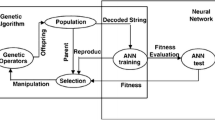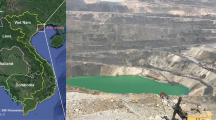Abstract
Blast operations in the vicinity of residential areas usually produce significant environmental problems which may cause severe damage to the nearby areas. Blast-induced air overpressure (AOp) is one of the most important environmental impacts of blast operations which needs to be predicted to minimize the potential risk of damage. This paper presents an artificial neural network (ANN) optimized by the imperialist competitive algorithm (ICA) for the prediction of AOp induced by quarry blasting. For this purpose, 95 blasting operations were precisely monitored in a granite quarry site in Malaysia and AOp values were recorded in each operation. Furthermore, the most influential parameters on AOp, including the maximum charge per delay and the distance between the blast-face and monitoring point, were measured and used to train the ICA-ANN model. Based on the generalized predictor equation and considering the measured data from the granite quarry site, a new empirical equation was developed to predict AOp. For comparison purposes, conventional ANN models were developed and compared with the ICA-ANN results. The results demonstrated that the proposed ICA-ANN model is able to predict blast-induced AOp more accurately than other presented techniques.













Similar content being viewed by others
References
Atashpaz-Gargari, E., Hashemzadeh, F., Rajabioun, R., & Lucas, C. (2008). Colonial competitive algorithm, a novel approach for PID controller design in MIMO distillation column process. International Journal of Intelligent Computing and Cybernetics, 1, 337–355.
Atashpaz-Gargari, E., & Lucas, C. (2007). Imperialist competitive algorithm: an algorithm for optimization inspired by imperialistic competition. IEEE Congress on Evolutionary Computation, 4661–4667.
Baker, W. E., Cox, P. A., Kulesz, J. J., Strehlow, R. A., & Westine, P. S. (1983). Explosion hazards and evaluation. Elsevier Science.
Cengiz, K. (2008). The importance of site-specific characters in prediction models for blast-induced ground vibrations. Soil Dynamics and Earthquake Engineering, 28, 405–414.
Fişne, A., Kuzu, C., & Hüdaverdi, T. (2011). Prediction of environmental impacts of quarry blasting operation using fuzzy logic. Environmental Monitoring and Assessment, 174, 461–470.
Griffiths, M. J., Oates, J. A. H., & Lord, P. (1978). The propagation of sound from quarry blasting. Journal of Sound and Vibration, 60, 359–370.
Hajihassani, M., Jahed Armaghani, D., Sohaei, H., Tonnizam Mohamad, E., & Marto, A. (2014). Prediction of airblast-overpressure induced by blasting using a hybrid artificial neural network and particle swarm optimization. Applied Acoustics, 80, 57–67.
Hajihassani, M. J., Armaghani, D., Marto, A., & Mohamad, E. T. (2015). Ground vibration prediction in quarry blasting through an artificial neural network optimized by imperialist competitive algorithm. Bulletin of Engineering Geology and the Environment, 74, 873–886.
Hopler, R. B. (1998). Blasters’ handbook. International Society of Explosives Engineers.
Hornik, K., Stinchcombe, M., & White, H. (1989). Multilayer feedforward networks are universal approximators. Neural Networks, 2, 359–366.
Hustrulid, W. A. (1999). Blasting principles for open pit mining: general design concepts. Balkema.
Jahed Armaghani, D., Hajihassani, M., Tonnizam Mohamad, E., Marto, A., & Noorani, S. A. (2014). Blasting-induced flyrock and ground vibration prediction through an expert artificial neural network based on particle swarm optimization. Arabian Journal of Geosciences, 7, 5383–5396.
Jahed Armaghani, D., Momeni, E., Alavi Nezhad Khalil Abad, S. V., & Khandelwal, M. (2015). Feasibility of ANFIS model for prediction of ground vibrations resulting from quarry blasting. Environmental Earth Sciences, 74, 2845–2860.
Khandelwal, M., & Kankar, P. K. (2011). Prediction of blast-induced air overpressure using support vector machine. Arabian Journal of Geoscience, 4, 427–433.
Khandelwal, M., & Singh, T. N. (2005). Prediction of blast induced air overpressure in opencast mine. Noise Vibration Worldwide, 36, 7–16.
Konya, C. J., & Walter, E. J. (1990). Surface blast design. Englewood Cliffs: Prentice-Hall.
Kuzu, C. (2008). The importance of site-specific characters in prediction models for blast-induced ground vibrations. Soil Dynamics and Earthquake Engineering, 28, 405–414.
Kuzu, C., Fisne, A., & Ercelebi, S. G. (2009). Operational and geological parameters in the assessing blast induced airblast-overpressure in quarries. Applied Acoustics, 70, 404–411.
Lusk, B. T., & Micah Hoffman, J. (2011). Analysis of survey information about airblast and ground vibration reporting units. International Journal of Mining, Reclamation and Environment, 25, 161–176.
Marto, A., Hajihassani, M., Jahed Armaghani, D., Tonnizam Mohamad, E., & Makhtar, A. M. (2014) A novel approach for blast-induced flyrock prediction based on imperialist competitive algorithm and artificial neural network. Scientific World Journal (Article ID 643715)
McCulloch, W. S., & Pitts, W. (1943). A logical calculus of the ideas immanent in nervous activity. Bulletin of Mathematical Biophysics, 5, 115–133.
Mohanty, B. (1998). Physics of explosions hazards. In A. Beveridge (Ed.), Forensic investigation of explosions (pp. 22–32). London.
Momeni, E., Nazir, R., Armaghani, D. J., & Maizir, H. (2015). Application of artificial neural network for predicting shaft and tip resistances of concrete piles. Earth Sciences Research Journal, 19(1), 85–93.
Pathak, K., Durucan, S., & Kunimatsu, S. (1999). Activity accounting technique for environmental noise assessment in mechanized surface mining. Environmental Monitoring and Assessment, 56, 241–256.
Persson, P. A., Holmberg, R., & Lee, J. (1994). Rock blasting and explosives engineering. CRC press.
Rafig, M. Y., Bugmann, G., & Easterbrook, D. J. (2001). Neural network design for engineering applications. Computers and Structures, 79, 1541–1552.
Rajabioun, E., Atashpaz-Gargari, E., & Lucas, C. (2008). Colonial competitive algorithm as a tool for Nash equilibrium point achievement. In Computational science and its applications-iccsa (pp. 680–695). Berlin Heidelberg: Springer.
Rodriguez, R., Lombardía, C., & Torno, S. (2010). Prediction of the air wave due to blasting inside tunnels: approximation to a ‘phonometric curve’. Tunneling and Underground Space Technology, 25, 483–489.
Rodriguez, R., Toraño, J., & Menendez, M. (2007). Prediction of the airblast wave effects near a tunnel advanced by drilling and blasting. Tunneling and Underground Space Technology, 22, 241–251.
Rosenthal, M. F., & Morlock, G. L. (1987). Blasting guidance manual. US Department of the Interior: Office of Surface Mining Reclamation and Enforcement.
Roy, P. P. (2005). Rock blasting: effects and operations. US: Taylor & Francis.
Segarra, P., Domingo, J. F., López, L. M., Sanchidrián, J. A., & Ortega, M. F. (2010). Prediction of near field overpressure from quarry blasting. Applied Acoustics, 71, 1169–1176.
Sepehri Rad, H., & Lucas, C. (2008). Application of imperialistic competition algorithm in recommender systems. In In: 13th International CSI Computer Conference (CSICC’08). Kish Island: Iran.
Singh, P. K., Sirveiya, A. K., Babu, K. N., Roy, M. P., & Singh, C. V. (2006). Evolution of effective charge weight per delay for prediction of ground vibrations generated from blasting in a limestone mine. International Journal of Mining, Reclamation and Environment, 20, 4–19.
Siskind, D. E., Stagg, M. S., Kopp, J. W., & Dowding, C. H. (1980). Structure response and damage produced by ground vibration from surface mine blasting. US Bureau of Mines, 8507, 74.
Stern, H. S. (1996). Neural networks in applied statistics. Technometrics, 38, 205–214.
Wiss, J. F., & Linehan, P. (1978). Control of vibration and blast noise from surface coal mining (p. 103). Research Report, Washington DC: US Bureau of Mines.
White, T. J., & Farnfield, R. A. (1983). Computers and blasting (p. 102). Transactions of the Institution of Mining and Metallurgy Section.
Acknowledgments
The authors would like to extend their appreciation to the Ministry of Science, Technology and Innovation, Malaysia through the provision of research grant No: 03-01-06-SF1185 (UTM 4S072) to undertake the research. Acknowledgement is also conveyed to the Universiti Teknologi Malaysia for providing the required facilities which made this research possible.
Author information
Authors and Affiliations
Corresponding author
Rights and permissions
About this article
Cite this article
Jahed Armaghani, D., Hajihassani, M., Marto, A. et al. Prediction of blast-induced air overpressure: a hybrid AI-based predictive model. Environ Monit Assess 187, 666 (2015). https://doi.org/10.1007/s10661-015-4895-6
Received:
Accepted:
Published:
DOI: https://doi.org/10.1007/s10661-015-4895-6




